A Semi-Empirical Model for Predicting Frost Properties
Abstract
1. Introduction
2. Methodology
2.1. Identification of Crystal Shape
- Determine the dew point temperature and cold plate temperature.
- Input two parameters of step 1 into Equations (9)–(11) and compare the calculated value with the constant term of Equations (9)–(11).
2.2. Semi-Empirical Correlation
2.3. Assumptions and Calculating Procedures
- The process of growing frost is a quasi-steady state.
- The effects of convection and radiation are neglected in the frost layer.
- The density distribution in the frost layer is uniform.
- The mass and heat transfer are one-dimensional.
- The thickness and density are invariant along the spanwise direction of the flat plate.
- The pressure and temperature of airflow are uniform along the free stream direction.
- The state of water vapor at the frost surface is saturation.
- The air and water vapor are considered as ideal gas.
- The heat and mass transfer in this model can be determined by Yamakawa et al.’s correlation [24], which is determined by Ta, V, and RHin, and Lewis’s relation. The thermal conductivity can be determined by the frost density ().
- The updated frost surface temperature (Tf,s) can be calculated by Equation (31). Yet, the updated frost surface temperature for each time step can be estimated through the bi-section method. The convergence of frost temperature between the initial guess and the calculating result is required during iterations.
- Determine the mass transfer for densification (mρ) and mass transfer for increasing thickness (mz) by using Equations (20) and (23). Subsequently, the thickness (Zf) and density () for the next time step can be obtained by discretizing equations, which are Equations (35) and (36).
- Consider the calculating results as the new initial conditions, calculation then proceeds to the next time step.
- When the calculation reaches the setting time, the calculation stops.
2.4. Numerical Model
3. Results and Discussion
3.1. Analysis of Collected Data and Comparison of Correlations
3.2. Performance of Numerical Model by Using Present Correlations
4. Conclusions
- The proposed procedures of linear programming for identifying the crystal geometry are in line with the previous frost crystal map.
- For identifying the crystal structure, the proposed model can identify the corresponding frost shape by a dimensionless temperature and the surface temperature.
- Comparisons of the proposed model and existing correlations indicate that the proposed model and the Na and Webb correlations are comparable in predicting the frost properties like thickness and thermal conductivity while the present model yields about 5% better prediction ability in frost density than Na and Webb’s correlation.
- The proposed calculation method not only shows better predictive ability with thermal conductivities, but also gives good predictions for density and is especially accurate when the frost density is lower than 125 kg/m3. Even when the density exceeds 125 kg/m3, the proposed calculation still outperforms the prediction of Negrelli and Hermes [7] by 14%.
Author Contributions
Funding
Institutional Review Board Statement
Informed Consent Statement
Data Availability Statement
Acknowledgments
Conflicts of Interest
References
- Song, M.; Dang, C. Review on the measurement and calculation of frost characteristics. Int. J. Heat Mass Transf. 2018, 124, 586–614. [Google Scholar] [CrossRef]
- Yonko, J.D. An investigation of the thermal conductivity of frost while forming on a flat horizontal plate. ASHRAE Trans. 1967, 73, 1.1–1.11. [Google Scholar]
- Brian, P.L.T.; Reid, R.C.; Shah, Y.T. Frost Deposition on Cold Surfaces. Ind. Eng. Chem. Fundam. 1970, 9, 375–380. [Google Scholar] [CrossRef]
- Östin, R.; Andersson, S. Frost growth parameters in a forced air stream. Int. J. Heat Mass Transf. 1991, 34, 1009–1017. [Google Scholar] [CrossRef]
- Lee, K.; Lee, T.; Kim, W. Heat and mass transfer of parallel plate heat exchanger under frosting condition. Korean J. Air-Cond. Refrig. Eng. 1994, 6, 155–165. [Google Scholar]
- Na, B.; Webb, R.L. New model for frost growth rate. Int. J. Heat Mass Transf. 2004, 47, 925–936. [Google Scholar] [CrossRef]
- Negrelli, S.; Hermes, C.J. A semi-empirical correlation for the thermal conductivity of frost. Int. J. Refrig. 2015, 58, 243–252. [Google Scholar] [CrossRef]
- Negrelli, S.; Nascimento, V.S., Jr.; Hermes, C.J. A study of the effective thermal conductivity of frost formed on parallel plate channels. Exp. Therm. Fluid Sci. 2016, 78, 301–308. [Google Scholar] [CrossRef]
- Leoni, A.; Mondot, M.; Durier, F.; Revellin, R.; Haberschill, P. Frost formation and development on flat plate: Experimental investigation and comparison to predictive methods. Exp. Therm. Fluid Sci. 2017, 88, 220–233. [Google Scholar] [CrossRef]
- Zhang, T.; O’Neal, D.L.; McClain, S.T. Analysis of frost thickness and roughness growth from the perspective of frost crystal structure. Int. J. Refrig. 2020, 112, 314–323. [Google Scholar] [CrossRef]
- Hayashi, Y.; Aoki, A.; Adachi, S.; Hori, K. Study of Frost Properties Correlating With Frost Formation Types. J. Heat Transf. 1977, 99, 239–245. [Google Scholar] [CrossRef]
- Auracher, H. Effective Thermal Conductivity of Frost. Int. Symp. Heat Mass Transf. Refrig. Cryog. 1986, 285–302. [Google Scholar] [CrossRef]
- Kobayashi, T. On the Habit of Snow Crystals Artificially Produced at Low Pressures. J. Meteorol. Soc. Jpn. 1958, 36, 193–208. [Google Scholar] [CrossRef]
- Liu, Z.; Gou, Y.; Wang, J.; Cheng, S. Frost formation on a super-hydrophobic surface under natural convection conditions. Int. J. Heat Mass Transf. 2008, 51, 5975–5982. [Google Scholar] [CrossRef]
- Piucco, R.O.; Hermes, C.J.; Melo, C.; Barbosa, J.R. A study of frost nucleation on flat surfaces. Exp. Therm. Fluid Sci. 2008, 32, 1710–1715. [Google Scholar] [CrossRef]
- Wu, X.; Dai, W.; Xu, W.; Tang, L. Mesoscale investigation of frost formation on a cold surface. Exp. Therm. Fluid Sci. 2007, 31, 1043–1048. [Google Scholar] [CrossRef]
- Mao, Y.; Besant, R.; Chen, H. Frost characteristics and heat transfer on a flat plate under freezer operating conditions: Part I, Experimentation and correlations. Ashrae Trans. 1999, 105, 231. [Google Scholar]
- Yang, D.-K.; Lee, K.-S. Dimensionless correlations of frost properties on a cold plate. Int. J. Refrig. 2004, 27, 89–96. [Google Scholar] [CrossRef]
- Tokura, I.; Saito, H.; Kishinami, K. Study on Properties and Growth Rate of Frost Layers on Cold Surfaces. J. Heat Transf. 1983, 105, 895–901. [Google Scholar] [CrossRef]
- Zendehboudi, A.; Hosseini, S.H.; Ahmadi, G. Modeling of frost thermal conductivity on parallel surface channels. Measurement 2019, 140, 293–304. [Google Scholar] [CrossRef]
- Lee, K.-S.; Kim, W.-S.; Lee, T.-H. A one-dimensional model for frost formation on a cold flat surface. Int. J. Heat Mass Transf. 1997, 40, 4359–4365. [Google Scholar] [CrossRef]
- Lee, Y.; Ro, S. Analysis of the frost growth on a flat plate by simple models of saturation and supersaturation. Exp. Therm. Fluid Sci. 2005, 29, 685–696. [Google Scholar] [CrossRef]
- Wang, W.; Guo, Q.; Lu, W.; Feng, Y.; Na, W. A generalized simple model for predicting frost growth on cold flat plate. Int. J. Refrig. 2012, 35, 475–486. [Google Scholar] [CrossRef]
- Yamakawa, N.; Takahashi, N.; Ohtani, S. Forced convection heat and mass transfer under frost conditions. J. Heat Transf.-Jpn. Res. 1972, 1, 1–10. [Google Scholar]
- Lemmon, E.; Huber, M.; McLinden, M. NIST Standard Reference Database 23: Reference Fluid Thermodynamic and Transport Properties-REFPROP; Version 8.0; National Institute of Standards and Technology, Standard Reference Data Program: Gaithersburg, MD, USA, 2007. [Google Scholar]
- Brèque, F.; Nemer, M. Frosting modeling on a cold flat plate: Comparison of the different assumptions and impacts on frost growth predictions. Int. J. Refrig. 2016, 69, 340–360. [Google Scholar] [CrossRef]
- Brian, P.L.T. Cryogenic frost properties. Cryog. Technol. 1969, 5, 205–212. [Google Scholar]
- Hermes, C.J.; Piucco, R.O.; Barbosa, J.R.; Melo, C. A study of frost growth and densification on flat surfaces. Exp. Therm. Fluid Sci. 2009, 33, 371–379. [Google Scholar] [CrossRef]
- Sherif, S.; Raju, S.; Padki, M.; Chan, A. A semi-empirical transient method for modelling frost formation on a flat plate. Int. J. Refrig. 1993, 16, 321–329. [Google Scholar] [CrossRef]
- Le Gall, R.; Grillot, J.; Jallut, C. Modelling of frost growth and densification. Int. J. Heat Mass Transf. 1997, 40, 3177–3187. [Google Scholar] [CrossRef]
- Ismail, K.; Salinas, C. Modeling of frost formation over parallel cold plates. Int. J. Refrig. 1999, 22, 425–441. [Google Scholar] [CrossRef]
- Mezedur, M.M.; Kaviany, M.; Moore, W. Effect of pore structure, randomness and size on effective mass diffusivity. AIChE J. 2002, 48, 15–24. [Google Scholar] [CrossRef]
- Sherwood, T.K.; Pigford, R.L. Absorption and Extraction; McGraw-Hill: New York, NY, USA, 1952. [Google Scholar]
- ASHRAE. American Society of Heating, Refrigerating and Air-Conditioning Engineers; ASHRAE Inc.: Atlanta, GA, USA, 2009. [Google Scholar]
- Jones, B.W.; Parker, J.D. Frost Formation with Varying Environmental Parameters. J. Heat Transf. 1975, 97, 255–259. [Google Scholar] [CrossRef]
- Sahin, A.Z. An experimental study on the initiation and growth of frost formation on a horizontal plate. Exp. Heat Transf. 1994, 7, 101–119. [Google Scholar] [CrossRef]
- Huang, L.; Liu, Z.; Liu, Y.; Gou, Y. Experimental study of frost growth on a horizontal cold surface under forced convection. J. Mech. Sci. Technol. 2010, 24, 1523–1529. [Google Scholar] [CrossRef]
- Lee, Y.; Ro, S. Frost formation on a vertical plate in simultaneously developing flow. Exp. Therm. Fluid Sci. 2002, 26, 939–945. [Google Scholar] [CrossRef]
- Lee, K.-S.; Jhee, S.; Yang, D.-K. Prediction of the frost formation on a cold flat surface. Int. J. Heat Mass Transf. 2003, 46, 3789–3796. [Google Scholar] [CrossRef]
- Liu, Y.; Liu, Z.; Huang, L.; Sun, J. Fractal model for simulation of frost formation and growth. Sci. China Ser. E Technol. Sci. 2010, 53, 807–812. [Google Scholar] [CrossRef]
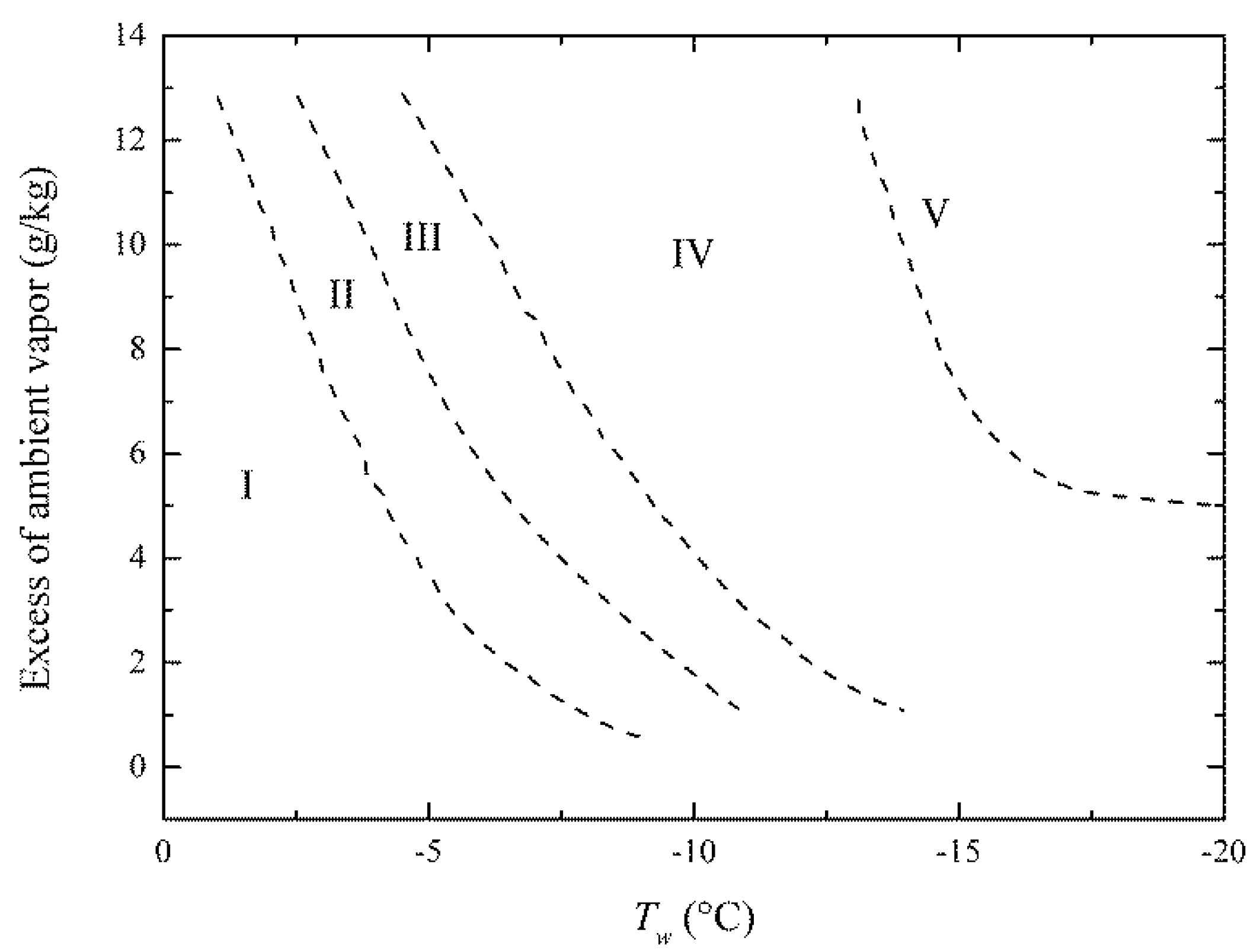
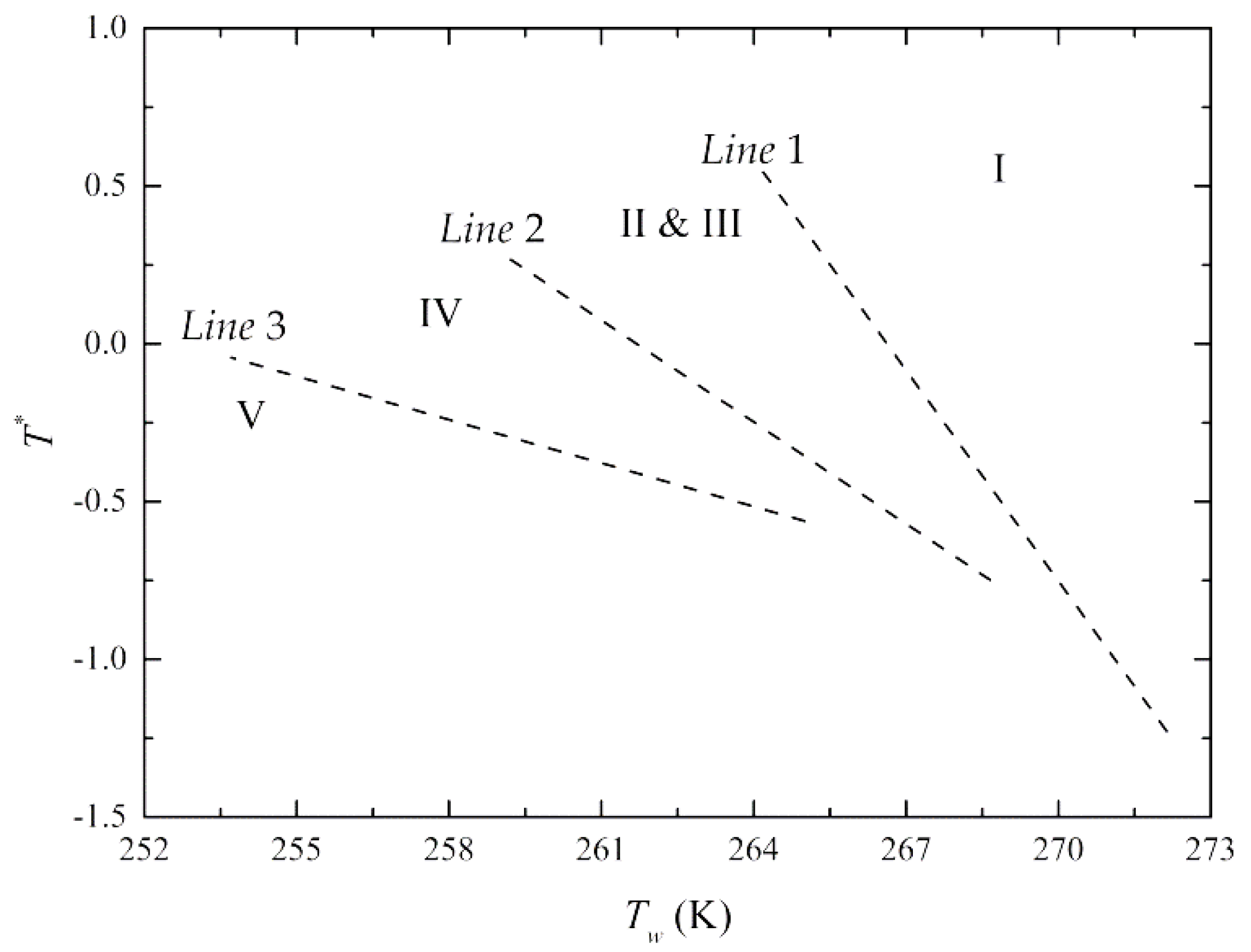

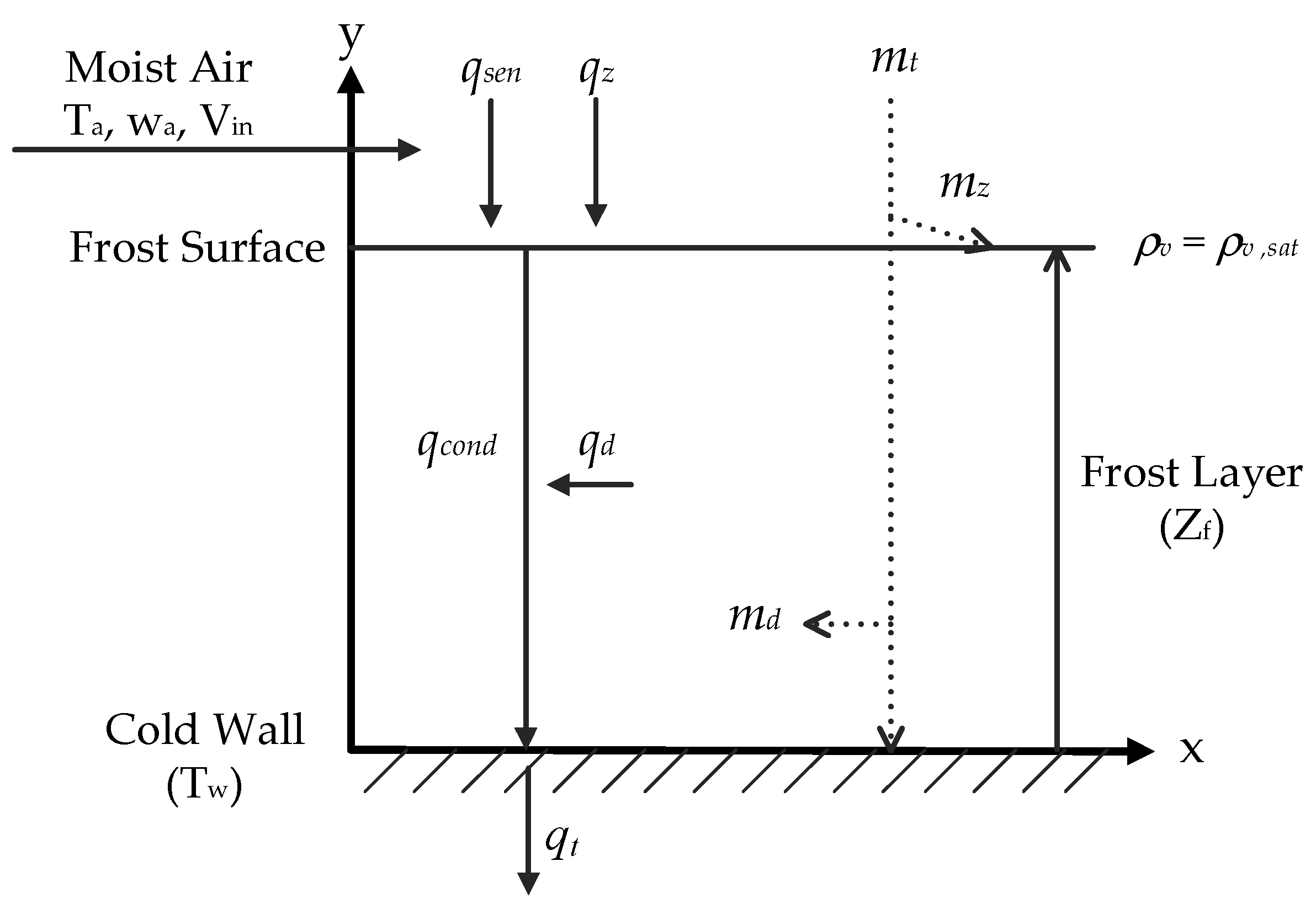
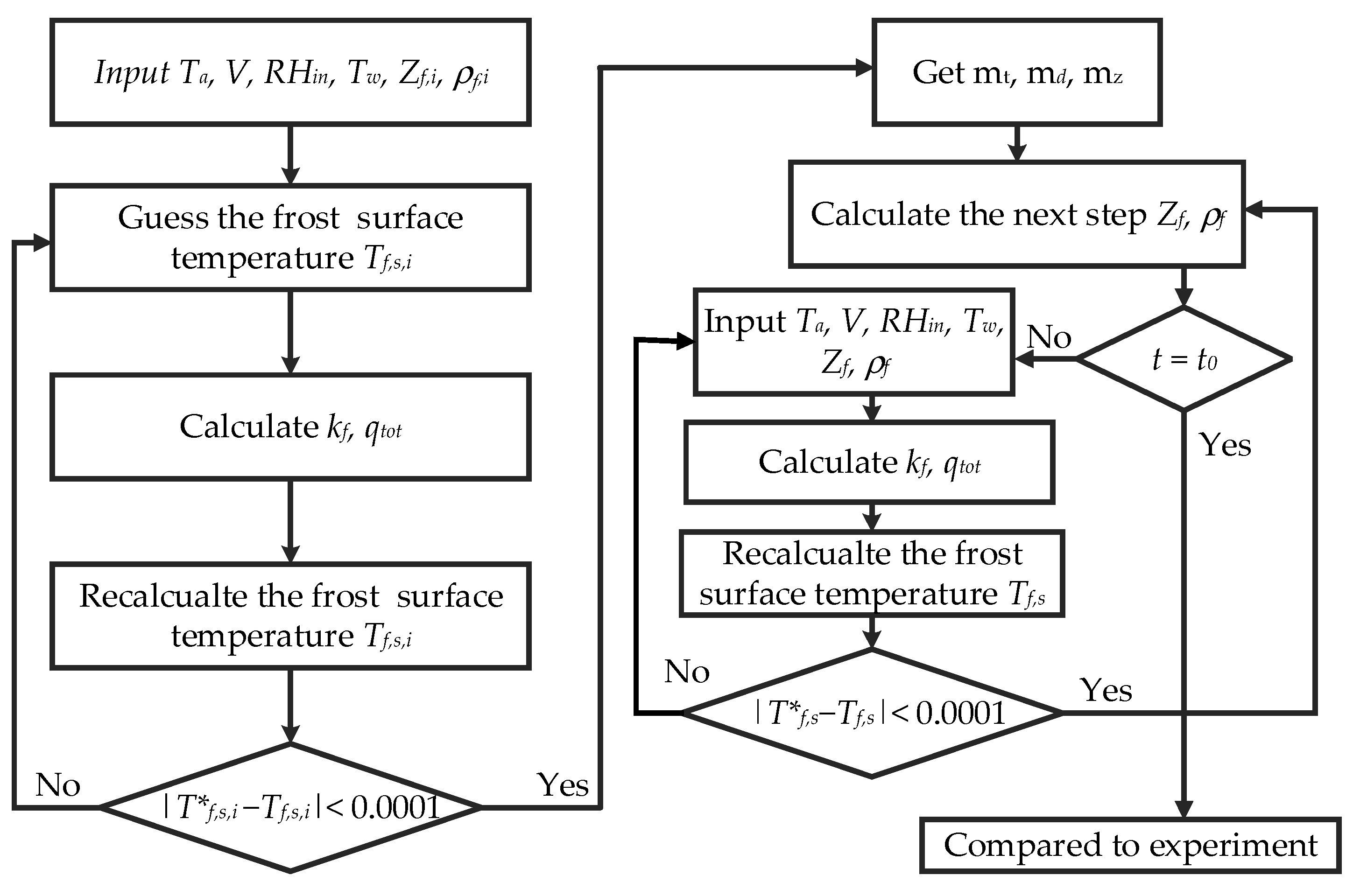

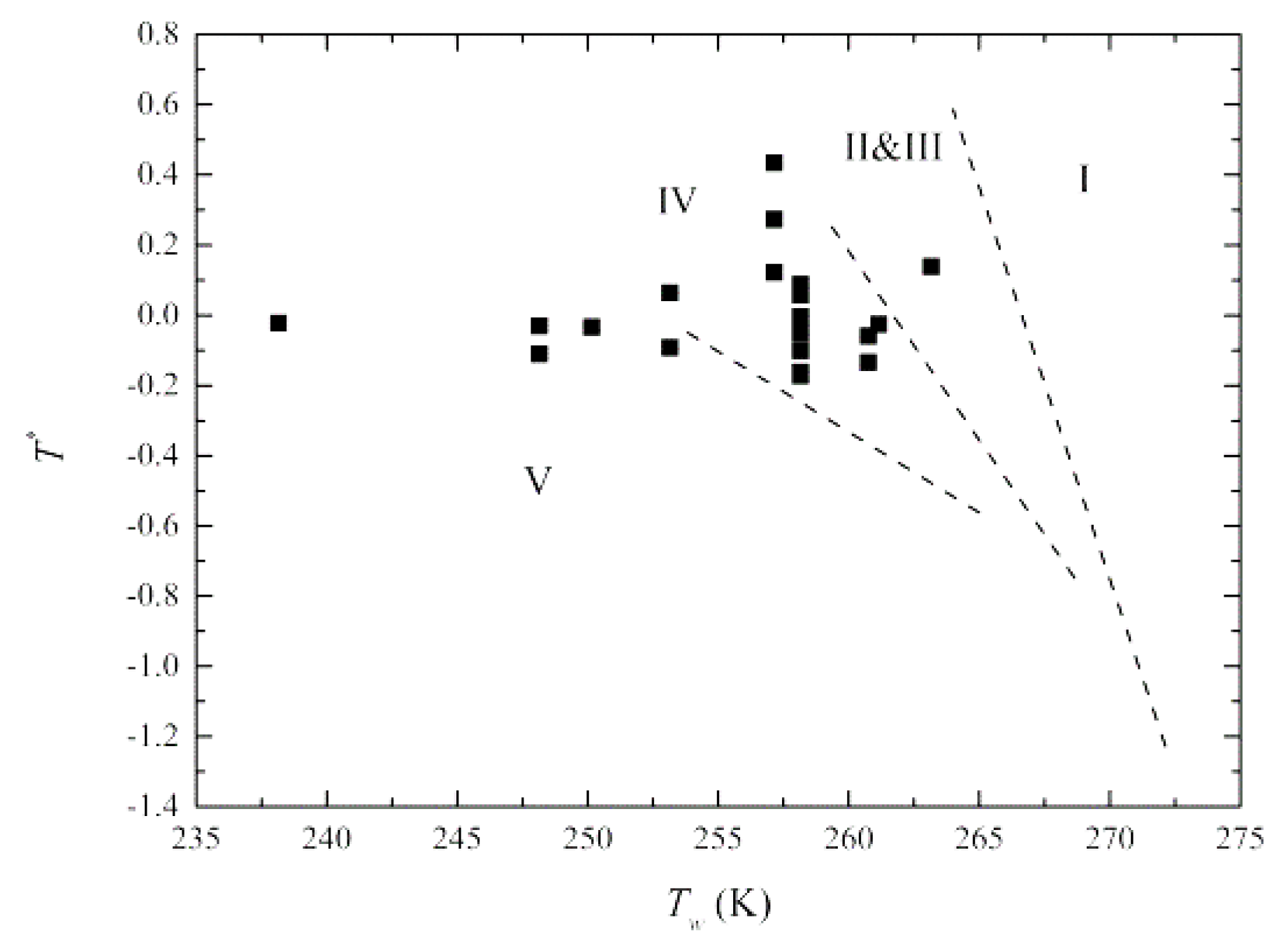


| Region | Morphology | a | b |
|---|---|---|---|
| II and III | Irregular and flake crystals | 1.545 | 0.801 |
| IV | Needle and pole crystals | 2.944 | 1.030 |
| V | Feather crystals | 1.743 | 0.860 |
| Coefficients | −100 ≤ T ≤ 0 °C | 0 ≤ T ≤ 200 °C |
|---|---|---|
| −5674.5359 | −5800.2206 | |
| 6.3925247 | 1.3914993 | |
| 0 | ||
| 4.1635019 | 6.5459653 |
| No. | Ta (°C) | wa (g/kg) | Tw (°C) | Vin (m/s) |
|---|---|---|---|---|
| 1 | 15 | 6.33 | −15 | 2.5 |
| 2 | 15 | 5.00 | −15 | 1.6 |
| 3 | 12 | 5.20 | −12.4 | 2 |
| 4 | 12 | 4.30 | −12.4 | 2 |
| 5 | 10 | 6.33 | −25 | 1 |
| 6 | 10 | 6.33 | −25 | 1.75 |
| 7 | 10 | 6.10 | −15 | 1.2 |
| 8 | 10 | 5.30 | −20 | 1.75 |
| 9 | 10 | 5.00 | −15 | 1.6 |
| 10 | 10 | 4.31 | −25 | 1 |
| 11 | 5 | 4.31 | −35 | 1 |
| 12 | 5 | 4.31 | −15 | 1 |
| 13 | 5 | 4.31 | −15 | 1 |
| 14 | 5 | 4.00 | −15 | 1.6 |
| 15 | 5 | 3.22 | −15 | 2.5 |
| 16 | 5 | 3.20 | −15 | 1 |
| 17 | 5 | 3.00 | −20 | 1.6 |
| 18 | 5 | 3.00 | −15 | 1.6 |
| 19 | 5 | 3.00 | −10 | 1.6 |
| 20 | 4 | 3.80 | −15 | 1.2 |
| 21 | 0 | 2.72 | −16 | 5 |
| 22 | 0 | 2.00 | −16 | 5 |
| 23 | 0 | 1.58 | −16 | 5 |
Publisher’s Note: MDPI stays neutral with regard to jurisdictional claims in published maps and institutional affiliations. |
© 2021 by the authors. Licensee MDPI, Basel, Switzerland. This article is an open access article distributed under the terms and conditions of the Creative Commons Attribution (CC BY) license (http://creativecommons.org/licenses/by/4.0/).
Share and Cite
Li, S.-M.; Yang, K.-S.; Wang, C.-C. A Semi-Empirical Model for Predicting Frost Properties. Processes 2021, 9, 412. https://doi.org/10.3390/pr9030412
Li S-M, Yang K-S, Wang C-C. A Semi-Empirical Model for Predicting Frost Properties. Processes. 2021; 9(3):412. https://doi.org/10.3390/pr9030412
Chicago/Turabian StyleLi, Shao-Ming, Kai-Shing Yang, and Chi-Chuan Wang. 2021. "A Semi-Empirical Model for Predicting Frost Properties" Processes 9, no. 3: 412. https://doi.org/10.3390/pr9030412
APA StyleLi, S.-M., Yang, K.-S., & Wang, C.-C. (2021). A Semi-Empirical Model for Predicting Frost Properties. Processes, 9(3), 412. https://doi.org/10.3390/pr9030412








